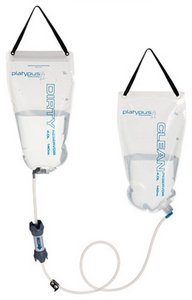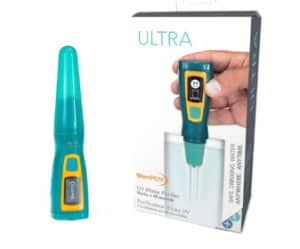
What are the best water filter and purification treatment systems used by backpackers? We asked backpackers whether they preferred squeeze-style water filters, pump water filters, gravity filter systems, chemical purification or purification using an ultraviolet light. We surveyed 1275 hikers in 2019 to ask them what water filters and treat methods they prefer. We found that 80% of them use just 10 different makes and models, which we list below, together with their average satisfaction ratings on a scale of 1-5, with 5 being the most favorable.
| Make / Model | Percentage | Rating | Type | Price |
|---|---|---|---|---|
| Sawyer Point One | 29.2% | 4.3 | Squeeze Filter | $40 |
| Sawyer Mini | 16.3% | 4.1 | Squeeze Filter | $20 |
| Katadyn BeFree | 7.5% | 4.4 | Squeeze Filter | $45 |
| Aquamira Water Treatment Drops | 5.3% | 4.5 | Chlorine Dioxide | $15 |
| Platypus Gravity Works | 5.3% | 4.3 | Gravity Filter | $110 |
| Katadyn Hiker | 4.9% | 4.4 | Pump Filter | $70 |
| Steripen Ultra | 3.9% | 4.4 | UV Purification | $110 |
| MSR Trailshot | 3.3% | 4.1 | Squeeze Filter | $50 |
| MSR Miniworks EX | 2.5% | 4.3 | Pump Filter | $90 |
| Sawyer Micro | 1.9% | 4.3 | Squeeze Filter | $29 |
Why does it matter what water filters and purifier methods other backpackers use? Your hiking peers have very similar needs as you. That doesn't mean that you have to use the same water filters as everyone else, but it gives you a good place to start looking if you're thinking about buying a new water filter or trying out chemical or ultraviolet water purification. So, don't just take our word for it. Here are the 10 best backpacking water filters and water purification systems recommended by other hikers and backpackers in 2019.
1. Sawyer Squeeze Water Filter
2. Sawyer Mini Water Filter
3. Katadyn BeFree Water Filter
4. Aquamira Water Purifications Drops
5. Platypus Gravity Works
6. Katadyn Hiker Water Filter
7. Steripen Ultra UV Water Purifier
8. MSR TrailShot Water Filter
9. MSR Miniworks EX Water Filter
10. Sawyer Micro Water Filter
Check out the latest price at:
Amazon
How to Choose a Backpacking Water Filter or Purifier
Many natural water sources contain microscopic organisms that can cause illness in humans. Most water filters intended for backcountry use will remove bacteria and protozoa, including giardia and cryptosporidium from these water sources. This is usually sufficient in the United States, Canada, and the UK. Viruses, often found in international water sources, are hard to remove because they are so small. Finer grained filters called purifiers are needed to remove them. They also can be neutralized with chemical purification agents such as chlorine dioxide or ultraviolet light.
There are a wide number of different water filter and purifier types available. Unfortunately, none of them are foolproof or perfectly suited for all kinds of trips and locales. They also differ in ease of use, the length of time it takes for them to process water, and whether they're good for solo or group use. Here's a brief summary of the different types and their strengths and weaknesses, with several examples to illustrate the available products in each category.
Squeeze Water Filters
Squeeze filters are single stage filters that are good for removing bacteria and protozoa, but not viruses. They're best used with clear water sources that are low in particulates and suspended organic matter to prevent clogging. Processing speed depends on the size of the "dirty" water bottle coupled with the filter and how much pressure the user exerts to push water through it. However, squeeze filters typically slow down with use and must be back-flushed with a cleaning syringe regularly to maintain their flow rate. Some examples:
Gravity and Inline Water Filters
Gravity water filters make it possible to process larger quantities of water at once using the power of gravity. A large water reservoir, called "the dirty bag" is hung from a tree with a hose leading to a water filter. The output of the filter flows out another hose to a clean reservoir, called the "clean bag." A squeeze style, single stage filter is typically used. Gravity filters are good for couples and small groups. An inline water filter uses a similar setup, but the user suck on the output hose rather than running it to clean bag. Some examples:
- Platypus Gravity Works 4 Liter Water Filter System
- Katadyn BeFree 3 Liter Gravity Water Filter System
- Sawyer 1 Gallon Gravity Filter System (designed for inline filter use)
Bottle and Straw Water Filters
Bottle and straw filters usually use the same single stage, hollow fiber filters used by squeeze, gravity, and inline water filter systems. The user sucks water stored in a bottle or directly from the water source through the filter, rather than transferring it to secondary storage. They are best used by individuals in places where water is abundant. Some examples:
Pump Water Filters and Purifiers
Pump water filters filter out bacteria and protozoa, while pump water purifiers can also remove viruses. They have hand pumps that force water through the filter and out to secondary storage for future use. While pump filters do require some elbow grease to operate, they usually filter water quite quickly and are suitable for use by couples as well as individuals. Most have a pre-filter at the end of the hose that you drop into the water source to remove particulates and organic matter. They can be cleaned and replacement filters are usually available. Some examples:
Chemical Water Purification
Chemical water purifiers are available in tablet or liquid form. The best chemical ingredient is chlorine dioxide, which has virtually no taste or color and kills bacteria, protzoa, and viruses. Chemical purification is best used by individuals rather than couple or groups because it takes anywhere from 15 minutes to 4 hours to fully purify water, far longer than other methods. While it is very lightweight, it is relatively expensive when compared to other methods. Many hikers carry chlorine dioxide as a backup to a second primary filter or purification method, as a result. Some examples:
Ultraviolet Light Water Purification
Ultraviolet Light is an effective form of water purification that neutralizes bacteria, protozoa, and viruses. It is best used with clear water since it doesn't remove any particulates or organic matter. While UV purification is relatively fast, it's not good for processing large quantities of water. It also depends on working batteries, which can run out of power. Some examples:
Methodology
How do we know what the top 10 best water filters and purification systems are? We survey our large readership to ask. If you'd like to participate in our surveys, be on the look up for the gear raffles we run every few weeks on SectionHiker, where we give survey participants a chance to win. Or sign up to the weekly, award-winning SectionHiker newsletter, so you never miss out on an opportunity to participate. We hate spam, so we'll never share your email with anyone else and you can unsubscribe at any time.
Check Out All of SectionHiker's Gear Guides!
- 10 Best Hiking Boots and Trail Shoes
- 10 Best Backpacking Tents
- 10 Best Backpacking Stoves
- 10 Best Backpacking Water Filters
- 10 Best Backpacking Sleeping Bags
- 10 Best Ultralight Backpacking Quilts
- 10 Best Backpacking Sleeping Pads
- 10 Best Backpacking Rain Jackets
- 10 Best Budget Backpacking Tents under $250
- 10 Best One Person Backpacking Tents
- 10 Best Ventilated Backpacks
- 10 Best Hiking Daypacks
- 10 Best Hiking Pants
- 10 Best Trekking Poles
The post 10 Best Backpacking Water Filters and Treatment Systems of 2019 appeared first on Section Hikers Backpacking Blog.
from Section Hikers Backpacking Blog http://bit.ly/2R3cd5t










No comments:
Post a Comment